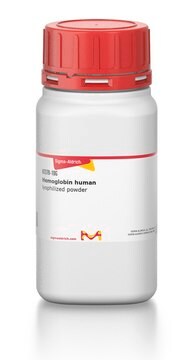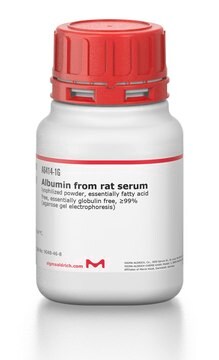Key Documents
A3782
Albumin from human serum
lyophilized powder, Fatty acid free, Globulin free, ≥99% (agarose gel electrophoresis)
Synonim(y):
HSA
About This Item
Polecane produkty
pochodzenie biologiczne
human
Poziom jakości
Próba
≥99% (agarose gel electrophoresis)
Postać
lyophilized powder
masa cząsteczkowa
monomer calculated mol wt 66478 Da
metody
ELISA: suitable
tissue culture: suitable
western blot: suitable
zanieczyszczenia
HIV I and HIVII, HCV and HBsAg, tested negative
≤0.1% Fatty acids
rozpuszczalność
H2O: soluble 50 mg/mL
numer dostępu UniProt
temp. przechowywania
2-8°C
InChI
1S/C3F8/c4-1(5,2(6,7)8)3(9,10)11
Klucz InChI
QYSGYZVSCZSLHT-UHFFFAOYSA-N
informacje o genach
human ... ALB(213)
Szukasz podobnych produktów? Odwiedź Przewodnik dotyczący porównywania produktów
Opis ogólny
Albumin is a known carrier of fatty acids (FA). Thus control over specific FA′s for cell culture is important, as different cell lines can differ in their sensitivity to particular fatty acids. Fatty acid-free human serum albumin (HSA) is therefore useful for cell culture studies where specific fatty acid content must be strictly controlled, so that researchers can use particular fatty acids specific to their cell lines. Fatty acid-free albumin also allows for optimal and maximum binding sites for using specific fatty acids in cell culture. The use of FA-free HSA also addresses concerns about endogenous FA′s potentially in non-FA-free HSA.
Albumin is widely used as a blocking agent in immunoassays and immunodetection procedures, and as a carrier protein for dilution of antibodies. Awareness of potential trace endogenous content of globulins / IgG in human serum albumin (HSA) is therefore important, because such trace globulins / IgG may serve as antigens for secondary antibodies in immunodetection work. This product undergoes testing for low globulin content / status as essentially globulin-free.
Zastosowanie
Działania biochem./fizjol.
Cechy i korzyści
- Fatty acid-free / low fatty acid content
- Globulin-free / low globulin content
Inne uwagi
Oświadczenie o zrzeczeniu się odpowiedzialności
Kod klasy składowania
11 - Combustible Solids
Klasa zagrożenia wodnego (WGK)
WGK 3
Temperatura zapłonu (°F)
Not applicable
Temperatura zapłonu (°C)
Not applicable
Środki ochrony indywidualnej
Eyeshields, Gloves
Certyfikaty analizy (CoA)
Poszukaj Certyfikaty analizy (CoA), wpisując numer partii/serii produktów. Numery serii i partii można znaleźć na etykiecie produktu po słowach „seria” lub „partia”.
Masz już ten produkt?
Dokumenty związane z niedawno zakupionymi produktami zostały zamieszczone w Bibliotece dokumentów.
Klienci oglądali również te produkty
Produkty
This page segues to comprehensive insights on how serum albumin and other important cell culture components affect the performance of serum-free cell culture systems used for biomanufacturing heterologous proteins including monoclonal antibodies. The page introduces the in vitro chemistry and biochemistry of albumin. These insights may also be applied to ex vivo and tissue engineering applications.
Lipid Induced Insulin Resistance
Nasz zespół naukowców ma doświadczenie we wszystkich obszarach badań, w tym w naukach przyrodniczych, materiałoznawstwie, syntezie chemicznej, chromatografii, analityce i wielu innych dziedzinach.
Skontaktuj się z zespołem ds. pomocy technicznej







